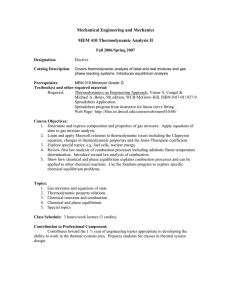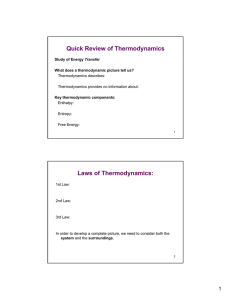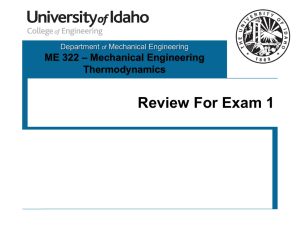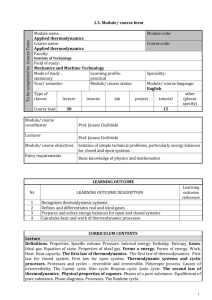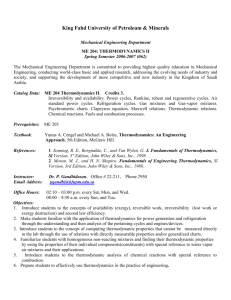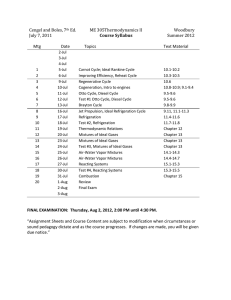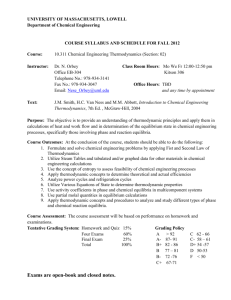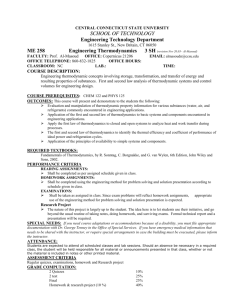Mechanical Engineering and Mechanics MEM 310 Thermodynamic Analysis I
advertisement
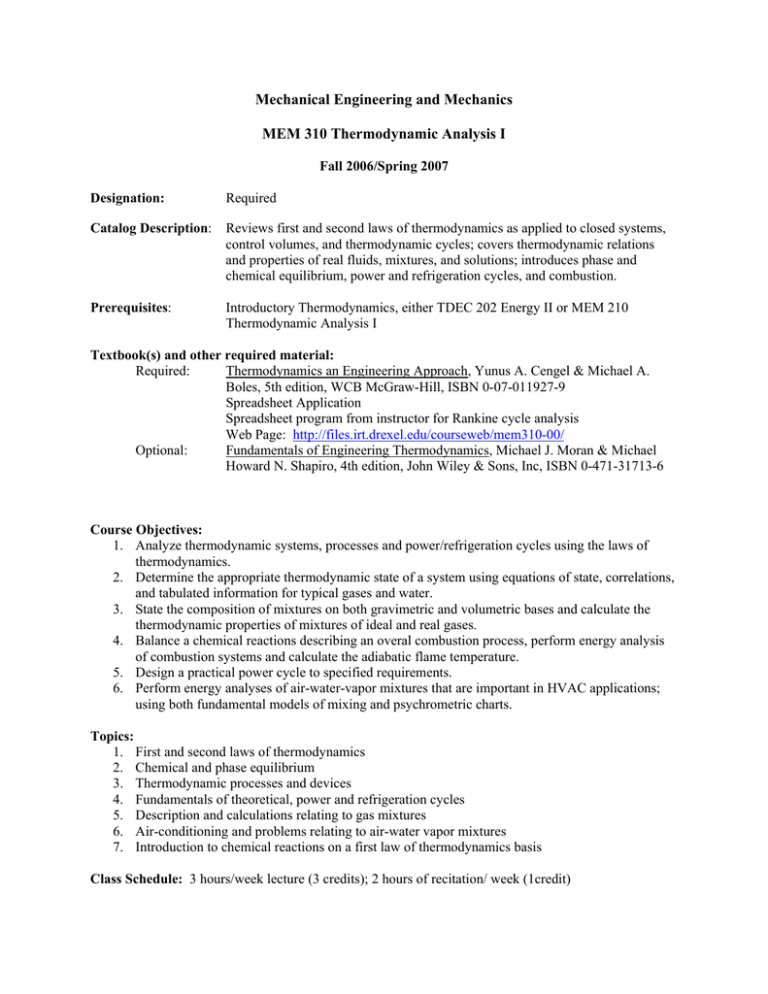
Mechanical Engineering and Mechanics MEM 310 Thermodynamic Analysis I Fall 2006/Spring 2007 Designation: Required Catalog Description: Reviews first and second laws of thermodynamics as applied to closed systems, control volumes, and thermodynamic cycles; covers thermodynamic relations and properties of real fluids, mixtures, and solutions; introduces phase and chemical equilibrium, power and refrigeration cycles, and combustion. Prerequisites: Introductory Thermodynamics, either TDEC 202 Energy II or MEM 210 Thermodynamic Analysis I Textbook(s) and other required material: Required: Thermodynamics an Engineering Approach, Yunus A. Cengel & Michael A. Boles, 5th edition, WCB McGraw-Hill, ISBN 0-07-011927-9 Spreadsheet Application Spreadsheet program from instructor for Rankine cycle analysis Web Page: http://files.irt.drexel.edu/courseweb/mem310-00/ Optional: Fundamentals of Engineering Thermodynamics, Michael J. Moran & Michael Howard N. Shapiro, 4th edition, John Wiley & Sons, Inc, ISBN 0-471-31713-6 Course Objectives: 1. Analyze thermodynamic systems, processes and power/refrigeration cycles using the laws of thermodynamics. 2. Determine the appropriate thermodynamic state of a system using equations of state, correlations, and tabulated information for typical gases and water. 3. State the composition of mixtures on both gravimetric and volumetric bases and calculate the thermodynamic properties of mixtures of ideal and real gases. 4. Balance a chemical reactions describing an overal combustion process, perform energy analysis of combustion systems and calculate the adiabatic flame temperature. 5. Design a practical power cycle to specified requirements. 6. Perform energy analyses of air-water-vapor mixtures that are important in HVAC applications; using both fundamental models of mixing and psychrometric charts. Topics: 1. First and second laws of thermodynamics 2. Chemical and phase equilibrium 3. Thermodynamic processes and devices 4. Fundamentals of theoretical, power and refrigeration cycles 5. Description and calculations relating to gas mixtures 6. Air-conditioning and problems relating to air-water vapor mixtures 7. Introduction to chemical reactions on a first law of thermodynamics basis Class Schedule: 3 hours/week lecture (3 credits); 2 hours of recitation/ week (1credit) Contribution to Professional Component: Contributes toward the 1 ½ year of engineering topics appropriate to developing the ability to work in the thermal systems area. Prepares students for classes in thermal system design. Relationship to Program Outcomes: Outcomes a - k a. An ability to apply knowledge of mathematics, science and engineering b. An ability to design and conduct experiments as well as to analyze and interpret data c. An ability to design a system, component or process to meet desired needs d. An ability to function on multidisciplinary teams e. An ability to identify, formulate and solve engineering problems Content Explanation 2 This course requires the students to develop a general understanding of thermodynamics. The students learn how to apply and synthesize their knowledge of mathematics, science, and engineering. 1 A design problem involving simple optimization requires the students generate data for a system and analyze them to find the optimized solutions. 2 The assigned design problems are always required to meet societal or industrial needs. 0 NA 2 f. An understanding of professional and ethical responsibility 1 g. An ability to communicate effectively h. The broad education necessary to understand the impact of engineering solutions in a global/societal context i. A recognition of the need for and an ability to engage in lifelong learning j. A knowledge of contemporary issues k. An ability to use the techniques, skills and modern engineering tools necessary for engineering practice 2 Prepared by: The problems and project require students to identify, formulate and solve engineering problems. This is emphasized as part of the engineer’s overall responsibility. 0 Written presentation of the final design problem is required. The impact of engineering design on the environment (pollution, greenhouse effect, etc.) and society are covered. NA 0 NA 2 Computer packages are used to explore the solution domain for homework and the design project 1 Dr. MinJun Kim, 15 November 2006 Evidence Homework, Exams, Design Project Final report for the design project; Classroom example and homework problems on Adiabatic Flame Calculations Final report for the design project NA Homework, exams, design project Classroom discussion of environmental issues; Final re for the design project Final report for the design project Classroom discussion of environmental issues; Final report for the design project Homework; Final report for the design project
